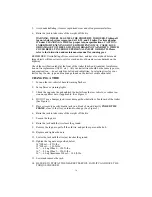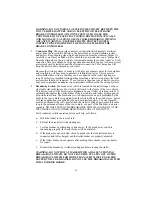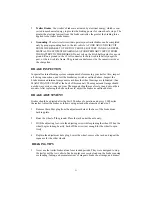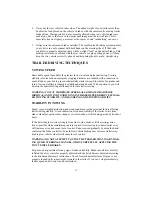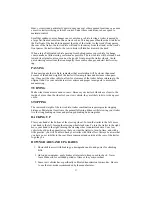
8
YOUR TRAVEL TRAILER — A TRUE
RECREATIONAL VEHICLE
Your travel trailer is a vacation home on wheels. It is carefully designed for every normal
recreational use and activity including travel. It is not designed or intended to be used as
long-term or permanent, full-time housing. Long-term or full-time occupancy may lead
to premature deterioration and may, under the terms of the warranty, constitute misuse
and reduce your warranty protection.
Please refer to page 31 of this manual and review the section relating to ventilation and
condensation problems that may occur due to long-term occupancy.
WARNING:
Never ride in your recreational vehicle.
Skyline strongly recommends that your recreational vehicle not be occupied while travel-
ing. It is unsafe and illegal to ride in a travel trailer in all states and it is illegal to ride in
a fi fth wheel in most states. Your recreational vehicle is not equipped with seat belts or
other highway safety provisions commonly required for passenger vehicles. Also in some
emergency conditions cargo could shift suddenly resulting in injury or even death.
DO’S AND DON’TS FOR EQUIPMENT SELECTION
AND PREPARATION FOR TOWING
•
Be sure the tow vehicle is large enough for your trailer or fi fth wheel and has the needed
power and heavy duty running gear. It must be rated by its manufacturer to tow the gross
weight, and to carry the hitch weight of the fully loaded trailer or fi fth wheel.
NOTE:
Heavy duty commercial vehicles larger than one ton may be used
only
if an
energy absorbing hitch, such as the Air Ride Hitch™, is used to couple the recreational
vehicle to the tow vehicle. The rough ride of the larger trucks can cause structural prob-
lems to develop in recreational vehicles if an energy absorbing hitch is not utilized.
•
Use a weight distributing hitch rated not less than the trailer Gross Vehicle Weight Rating
(GVWR). Follow the tow vehicle and hitch manufacturers' instructions. Install the hitch
ball as close as practical to the rear bumper to minimize rear overhang. (Does not apply
to fi fth wheels.)
•
Do not overtighten the weight distributing hitch spring bars. Follow the instructions of
the hitch manufacturer. When in doubt, use the less tight spring bar setting. (Does not ap-
ply to fi fth wheels.)
•
Use a sway control system. Install and adjust according to the instructions of the sway
control manufacturer. (Does not apply to fi fth wheels.)
•
Use a brake controller that automatically applies the brakes in proportion to the tow
vehicle brakes and also has a hand control for applying the trailer brakes only.
•
Adjust the brake controller so that the brakes of the trailer come on as quickly as possible
without sliding the tires of the loaded trailer during strong braking.
• Infl ate the rear tires of the tow vehicle to their maximum cold pressure. (See the maxi-
mum pressure rating on the rear tire sidewalls.)
•
Load heavy objects and goods as close to the trailer axle(s) as possible. Do not place
heavy objects on the rear bumper or on the tongue.
Your trailer may be equipped with an optional spare tire mounted on the bumper. The bumper
is designed only to carry the spare tire, approximately 65 pounds. If the trailer is not equipped
with a spare, no load greater than 65 pounds shall be placed on the bumper.
Содержание TRAVEL TRAILER FIFTH WHEEL
Страница 1: ...1 TRAVEL TRAILER FIFTH WHEEL OWNERS MANUAL This Quality Recreational Vehicle Built By...
Страница 4: ...4...
Страница 17: ...17 Figure 3 NEVER USE BUMPER JACKS Figure 2 TYPICAL SCISSOR JACK Figure 1 TYPICAL WHEEL CHOCKS...
Страница 64: ...64 TRAVEL TRAILER AND FIFTH WHEEL SLIDE OUT ROOM ADJUSTMENT AND OPERATION...
Страница 81: ...NOTES...
Страница 82: ...NOTES...
Страница 83: ...Corporate Of ce P O Box 743 Elkhart Indiana 46514 1584 1 800 755 6521 05 05...


















